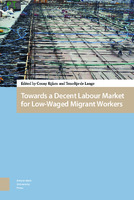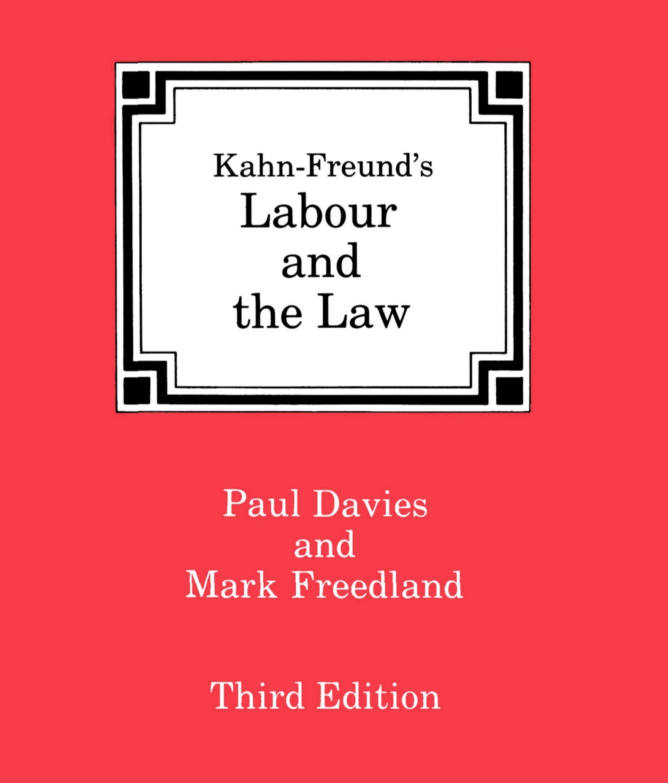
 Towards a Decent Labour Market for Low-Waged Migrant Workers
by
Rijken, Conny
Towards a Decent Labour Market for Low-Waged Migrant Workers presents ground breaking research on policies and practices in search of striking a right balance between the economic ambitions and the negative consequences thereof, for labour market dynamics such as down-ward wage pressures, unfair competition, the abuse of migrant workers and even the long-term setback for the children of previously low-waged migrant workers.
Towards a Decent Labour Market for Low-Waged Migrant Workers
by
Rijken, Conny
Towards a Decent Labour Market for Low-Waged Migrant Workers presents ground breaking research on policies and practices in search of striking a right balance between the economic ambitions and the negative consequences thereof, for labour market dynamics such as down-ward wage pressures, unfair competition, the abuse of migrant workers and even the long-term setback for the children of previously low-waged migrant workers.
 Kahn-Freund's Labour and the Law
by
Paul Davies
Collective labor agreements
Collective labor agreements Great Britain
Droit du travail
Great Britain
Great Britain Industrial relations Law
Labor laws and legislation
Labor laws and legislation Great Britain
Royaume-Uni
Travail Droit Grande-Bretagne
UE/CE Etats membres
Kahn-Freund's Labour and the Law
by
Paul Davies
Collective labor agreements
Collective labor agreements Great Britain
Droit du travail
Great Britain
Great Britain Industrial relations Law
Labor laws and legislation
Labor laws and legislation Great Britain
Royaume-Uni
Travail Droit Grande-Bretagne
UE/CE Etats membres
Labour Law and Employment Law are related but the terms should not be used interchangeably. Labour Law in South Africa typically focuses on unions and collective bargaining between unions and employers. By contrast, Employment Law governs the employment relationship between individual employees and their employer. The two areas of law are closely related but are often distinct areas of legal practice.
Labour law in South Africa is a set of laws and regulations that govern the relationships between employers, employees, and trade unions. The aim of these laws is to promote social justice, protect workers' rights, and regulate the relationship between employers and employees.
The main sources of labour law in South Africa are the Constitution of the Republic of South Africa, the Labour Relations Act, the Basic Conditions of Employment Act, and the Employment Equity Act.
The Labour Relations Act governs the relationship between employers, employees, and trade unions. It provides for the right to form and join trade unions, the right to engage in collective bargaining, and the right to strike. The Act also regulates unfair labour practices, dismissals, and disputes.
The Basic Conditions of Employment Act provides for minimum terms and conditions of employment, including working hours, leave, and pay. It also regulates employment of children, working conditions, and termination of employment.
The Employment Equity Act is aimed at promoting equality in the workplace and prohibits unfair discrimination on the grounds of race, gender, age, disability, and other grounds. It requires employers to implement affirmative action measures to redress past discrimination and achieve employment equity.
In addition to these main acts, there are also other regulations and guidelines that provide further protection to workers, such as the Occupational Health and Safety Act, the Compensation for Occupational Injuries and Diseases Act, and the National Minimum Wage Act.
Overall, labour law in South Africa is aimed at promoting social justice, protecting workers' rights, and ensuring that employers and employees have a fair and regulated relationship.
The Native Labour Regulations Act 1911 prohibited strikes by trade unions, introduced wage ceilings and a pass system for moving around jobs. Over 70,000 Chinese labourers were brought in, and used by landowners to undercut the wages of other workers. Among white workers, there was significant unrest, and major strikes took place in 1907, 1913, 1914 and 1922
For a period of sixteen years, from 1979 to 1995, several critical developments occurred in the field of labour law in South Africa, beginning with a radical change in the first of these years, when a significant Commission of Enquiry was held, resulting in the establishment of an Industrial Court, which was given extensive powers to mould, change, shape and develop the law. Prior to 1995, most labour relations were based on contracts. In 1995, much of the law developed by the Commission and the Industrial Court was put together in the Labour Relations Act 1995 (LRA). Since then, most labour law has been based on statute.
Prior to 1995, an employee could be dismissed in terms of the contract of employment, which could permit any reason for dismissal. Since 1995, an employee may be dismissed only for misconduct, operational reasons and incapacity. The Labour Relations Act 1995 is a pivotal piece of legislation, as it recognises the need for fast and easy access to justice in labour disputes. The Industrial Court had the status of a High Court, and therefore was not accessible to all labourers.
1995 also saw the introduction of the Commission for Conciliation, Mediation and Arbitration (CCMA) which is an administrative tribunal. The Commission for Conciliation, Mediation and Arbitration endeavours first and foremost to conciliate between the parties. If it is unsuccessful in this, the matter moves on to arbitration. The entire process is very informal, and at no charge, and is therefore very accessible to labourers, who often utilise it: About 300 new cases are brought before the Commission for Conciliation, Mediation and Arbitration daily. In addition to the Commission for Conciliation, Mediation and Arbitration, 1995 saw the introduction of bargaining councils, which allow for communication across the industry. A bargaining council is organised collectively and voluntarily, and must be registered. In order to be registered, an alternative-dispute-resolution mechanism, similar to the Commission for Conciliation, Mediation and Arbitration, must be put in place.
The Labour Relations Act 1995 also regulated the issue of fairness, not only in termination but during employment, too. In 1998, however, most of the law on unfair labour practices was removed from the Labour Relations Act 1995 and put into the Employment Equity Act (EEA). The EEA also deals with issues such as fairness regarding a worker’s human immunodeficiency virus (HIV) status or disability, as well as the issue of affirmative action.
The Basic Conditions of Employment Act (BCEA), the Health and Safety Acts and the Skills Development Act, must be read with the EEA. The Skills Development Act provides that a small percentage of a labourer’s salary must be contributed to the Department of Labour, enabling certain workshops to be run which are designed to develop skills.

University of the Western Cape,
Robert Sobukwe Road,
Bellville,
7535
Tel: 021 959 2946
